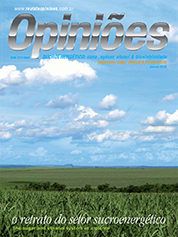Welber Oliveira Barral
Secretary of Foreign Trade of MIC
Op-AA-25
From intervention to free iniciative
For more than six decades beginning in 1930, Brazilian producers of sugarcane, sugar and ethanol were under full governmental intervention. The Federal Government decided on the industry’s activities, keeping it from being exposed to the influence of the markets. Intervention’s objective was to reorganize agro industry that was experiencing a critical period of over-production and difficulty in accessing foreign markets.
Government management was in line with international movements that defended the strong presence of the State in the economy. For the duration of the intervention by government, very little was left for the industry’s entrepreneurs to undertake. All decisions, such as how much and what to produce, how much and at what prices to sell, were made by the government.
Subsequently, the Constitution of 1988 redefined the role of the State, attributing it the functions of inspecting, fostering and planning, which are inherent to the public sector, but merely indicative for the private sector. As a result, the industry went from government to private management, in a process initiated at the end of the eighties and concluded at the end of the nineties.
Nowadays, the industry is growing in a sustainable manner due to appropriate entrepreneurial modifications and adaptations, designed to face current challenges. Brazil and the International Market: In the international context, Brazil, India, China, Thailand and Mexico are the countries that stand out most in sugarcane production, whereas the Brazilian sugar and ethanol industry, the most independent of government intervention, is the largest producer, with 514 million tons and a 33% share of the world total in 2007.
In terms of sugarcane production, Brazil also held the leading position between 1999 and 2008, except only for 2000, when the European Union produced 3.8 million more tons. In 2008, Brazil accounted for 20% of world production, the European Union for 12%, India for 10% and China for 9%. Data published by the United States Department of Agriculture - USDA, in May 2010, showed that the world production in the 2010/2011 season is estimated at 163.8 million tons, 11.6 million above the estimate for the 2010/2011 season (152.2 million tons).
This increase was due to higher production in India and Brazil, which increased, respectively, to 24.7 million tons (5.2 million more than in the previous season) and 40.7 million tons (additional 4.3 million tons). Brazil accounts for 25% of world production and Asia (mainly India, China and Thailand) for 38%. Brazilian sugar export performance in comparison with that of all other countries also stood out in 2008, with the Brazilian share reaching 41%, followed by Thailand with 11% and Australia with 8%. The analysis of sugar exports in the last three years shows the great leap that occurred in 2009, when sales increased 53%, from US$ 5.5 billion to US$ 8.4 billion.
The result in the first semester of 2010, compared with the same period in 2009, showed an increase of 52% in export value, having increased from US$ 3.2 billion to 4.8 billion while, however, stabilizing the quantity, which increased by 0.9%, to-taling 10.4 million tons. The development of Brazilian sugar exports (unrefined and refined), from 1989 to 2008, followed an increasing trend, having exceeded the US$ 2 billion mark in 2001. The peak occurred in 2006, with exports totaling US$ 6.1 billion.
In the two subsequent years, there was a slight reduction that did not, however, affect the increasing trend. With respect to ethanol, beginning in 2000/2001, Brazilian production picked up again, maintaining output until the 2008/2009 season, with a record volume of 27.6 million m3. Brazilian ethanol exports began growing exponentially in 2004, from the US$ 100 million level to US$ 500 million. In 2008, the highest peak was reached, with exports amounting to US$ 2.4 billion.
In this scenario, the Brazilian government is seeking to encourage the use of ethanol as fuel, also by means of partnerships with other developing countries that may develop to become, in the near future, producers and exporters. This initiative, along with the quest to bring about product standardization and its harmonized classification, will allow creating an international market and attracting other countries interested in upholding global free trade of ethanol. The Industry’s Future with Free Trade: This overall scenario shows that the national sugarcane industry found the path to prosperity with free trade.
The most significant changes are beginning to be noticed more clearly, with foreign capital flowing into one of the originally most traditional sectors of the Brazilian economy, and into the growing production and supply of agro energy. Sugarcane agro industry’s output will continue to grow because of the relevant role private initiative plays in modern economics in warranting companies’ success and by contributing updated fundamental concepts, such as sustainability and corporate governance.




